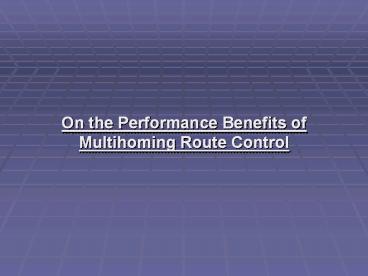on the performance benifits of multihoming route control - PowerPoint PPT Presentation
Title:
on the performance benifits of multihoming route control
Description:
for college project work – PowerPoint PPT presentation
Number of Views:289
Title: on the performance benifits of multihoming route control
1
- On the Performance Benefits of Multihoming Route
Control
2
Objective
- Multihoming is increasingly being employed by
large enterprises and data centers to extract
good performance and reliability from their ISP
connections. - Multihomed end networks today can employ a
variety of route control products to optimize
their Internet access performance and
reliability. - we present an in-depth study of the performance
- benefits of multihoming route control products
3
Existing System
- Multihoming to multiple Internet Service
Providers (ISPs) has traditionally been employed
by end-networks to ensure reliability of Internet
access. - Multihoming is increasingly being employed by
large enterprises and data centers to extract
good performance and reliability from their ISP
connections.
4
- Multihomed end-networks can employ a variety of
route control products to optimize their Internet
access performance and reliability. - A number of products provide these route control
capabilities to large enterprise customers which
have their own public AS number and advertise
their IP address prefixes to upstream ISPs using
BGP (Border Gateway Protocol).
5
- Other products extend these advantages to smaller
multihomed organizations which do not use BGP. - All of these products use a variety of mechanisms
and policies for route control, but their
quantitative benefits are not known.
6
Proposed System
- Multihoming route control does not require any
modification to Internet routing protocols and
relies on end-newteork decisions. - The term k-multihoming refers to the setting in
which the subscriber network employs k ISPs and
controls how traffic is sent or received along
the ISP links.
7
- Analysis of k-multihoming shows that RTT(Round
Trip Time) performance can potentially improve up
to 25 when an end-network connects to two
well-chosen ISPs. - Similarly, 20 higher transfer speeds are
obtained from multihoming to two or three ISPs.
8
- We analyze a study of the potential improvements
in Internet round- trip times and transfer speeds
from employing multihoming route control. - Analysis shows that multihoming to three or more
ISPs and cleverly scheduling traffic across the
ISPs can improve Internet RTTs and throughputs by
up to 25 and 20 respectively.
9
Modules
- We propose the following modules
- Client module
- ISP module
- Multihoming performance module
- Load balancing server module
10
Client module
- This module authorizes a client. A client can
access files and other resources by selecting a
suitable file format. Then the client can select
a specific file.
11
ISP module
- This module obtains a download request from main
server. Using synchronization techniques the
module processes each client request.
12
Multihoming performance module
- We maintain the details of files and ISPs.
Information about frequently accessed files and
the ISP used for accessing that file will be
stored here. If a ISP has any problem, the
requests are handed over to another ISP.
13
Load balancing server module
- This module verifies client requests. It
periodically performs dynamic one shot load
balancing. It maintains threshold values for
processing time of each client request.
14
Conclusions
- Our goal was to quantify the performance
improvements from route control and evaluate
practical mechanisms and policies for realizing
the performance bents in practice. We used
measurements on the Akamais server network to
show that multihoming to 2 or 3 ISPs can
significantly improve Internet download
performance. We discussed how to choose ISPs for
multihoming. Further, we evaluated the Web
performance of a real Linux-based enterprise
route control implementation. We employed an
emulated wide-area network tested and
experimentally evaluated several design
alternatives. Our evaluation shows that both
active and passive measurement-based route
control schemes offer significant performance
bents in practice, between 15 and 25, when
compared with using the single best-performing
ISP. Our experiments also show that the most
current measurement sample gives a good estimate
of ISP performance. We also showed that the
performance penalty from collecting and managing
performance data across various destinations is
negligible.
15
Hardware Requirements
- Processor Pentium
- RAM 1 GB
16
Software Requirements
- JDK5.0
- Java Swings
- MS-Access































